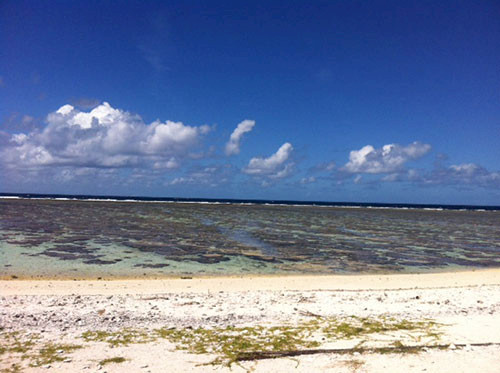Biophilia on a coral cay: Reflections from Lady Elliot Island
Bill Dennison ·Standing on the coral rubble of a small cay in the Great Barrier Reef (Lady Elliot Island) is a biophilia experience. Biophilia, defined as 'love of life', is an appreciation that everything that you see and touch on the coral cay is created from living things. This term was coined by the philosopher Erich Fromm in 1964 his book "The Heart of Man" and articulated by Edward O. Wilson in his book "Biophilia" in 1984. Wilson defines biophilia as the innate urge to affiliate with other living things. Either definition fits the feeling that is gained from the crunch of coral skeletons beneath your feet while viewing the turquoise reef surrounding the coral cay. Diving or snorkeling at the reef edge also reinforces an appreciation of the giant living thing that a coral reef constitutes. If it were not for the action of corals and various other calcifying organisms, the surrounding 20-30 meter deep seafloor would have been continuous, rather than rising up to form a reef crest, back reef, lagoon, and actual dry land created from the bits of coral skeletons, giant clam shells and algal remnants as well as sand created from the weathering of these calcifying organisms.

The small bit of dry land created by the accumulation of calcium carbonate then becomes an oasis for additional life amid an oceanic desert. Birds roost on the island and concentrate nutrients that they gather from the surrounding sea by catching fish and other marine animals. These nutrients support trees and shrubs, particularly the octopus bush, Pisonia, Pandanus and Casuarina trees, which in turn provide roosting and nesting sites for seabirds. The earthy smell, constant motion and noisy sounds of the island seabirds also contributes to the immersive feeling of being surrounded by living things. The immersive feeling is even more pronounced snorkeling on the reef, with small and large fish darting about, sharks cruising along, manta rays flying acrobatically through the water column and sea turtles lazing at the surface or feeding on the bottom.
The highlight of our visit to Lady Elliot Island and the most intense biophilia experience was witnessing over a hundred tiny loggerhead turtle hatchlings climb out of their burrow and scurry down the beach to swim toward open water. The surviving turtles will spend the next several decades in the deep blue sea before returning to the reef. Watching these little hatchlings emerge from their burrow was as if life was spontaneously springing literally from the coral cay itself (never mind the mighty struggle that the mother turtle had made 6-8 weeks ago to drag herself out of the water, climb up a steep beach, dig an egg chamber and lay 120-150 eggs over the course of a night).

Other than the man-made materials brought in by the eco-resort, the only non-biological component that I could discern on Lady Elliot Island was a large amount of pumice that was washing into the beach. Some of the pumice was very large (grapefruit-sized) with goose-necked barnacles attached, indicative of a long time at sea. The Australian newspapers noted seismic activity near Tonga and the East Australia Current as the source and conveyance, respectively, of the pumice.

My PhD was through the Pritzker School of Medicine at The University of Chicago which brought me in close contact with surgeons. I would often have surgeons tell me about their passion for scuba diving and they would often say "If I wasn't a surgeon, I would be a marine biologist". Since I often feel the reciprocal "If I weren't a marine biologist, I would be a surgeon", it has occurred to me that the unifying theme of surgery and marine biology is biophilia. Immersed in a coral reef surrounded by fish or immersed in a living human being is an intense biophilia experience.
About the author
Bill Dennison

Dr. Bill Dennison is a Professor of Marine Science and Vice President for Science Application at the University of Maryland Center for Environmental Science.

